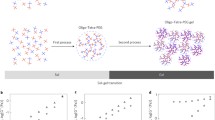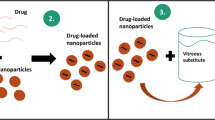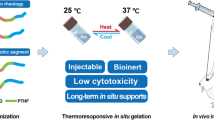Abstract
PVA based hydrogels were synthesised using, as crosslinking agent, trisodium trimetaphosphate (STMP) to obtain potential substitutes for the vitreous body of the eye. The hydrogels, obtained using different amounts of STMP, were characterised by Infrared Spectroscopy which confirmed the successful occurrence of crosslinking reaction. The mechanical spectra of the fully hydrated samples confirmed covalently crosslinked systems (i.e. G′ > G″). The rheological analysis pointed out that only one of the hydrogels (PVA STMP 8:1) showed a behaviour similar to that of human vitreous. The hydrogel was also subjected to injection through a small needle, a procedure that is essential in the use of vitreous substitutes. Further analysis in terms of light transmittance, water content measurements, diffusion coefficient and cytotoxicity confirmed the applicability of such a hydrogel as vitreous substitute.








Similar content being viewed by others
References
Chirila TV, Hong YE, Dalton PD, Constable IJ, Refojo MF. The use of hydrophilic polymers as artificial vitreous. Prog Polym Sci. 1998;23:475–508.
Chirila TV, Hong YE. Poly(1-vinyl-2-pyrrolidinone) hydrogels as vitreous substitutes: a rheological study. Pol Int. 1998;46:183–95.
Liesegang TJ. Viscoelastics. Int Ophthalmol Clin. 1993;33:127–47.
Fernandez-Vigo J, Refojo MF, Verstraeten T. Evaluation of a viscoelastic solution of hydroxypropyl methylcellulose as a potential vitreous substitute. Retina. 1990;10:148–52.
Lloyd AW, Faragher RGA, Denyer SP. Ocular biomaterials and implants. Biomaterials. 2001;22:769–85.
Mukai N, Lee PF, Oguri M, Schepens CL. A longterm evaluation of silicone retinopathy in monkeys. Can J Ophthalmol. 1975;10:391–402.
Sugar HS, Okamura ID. Intravitreal silicone injection. Arch Ophthalmol. 1976;94:612–5.
Eckardt C, Nicolai U, Czank M, Schmidt D. Identification of silicone oil in the retina after intravitreal injection. Retina. 1992;12:17–22.
Kirchhof B, Tavakolian U, Paulmann H, Heimann K. Histopathological findings in eyes after silicone oil injection. Graefe’s Arch Clin Exp Ophthalmol. 1986;224:34–7.
Budde M, Cursifen C, Holbach LM, Naumann GOH. Silicone oil-associated optic nerve degeneration. Am J Ophthalmol. 2001;131:392–4.
Couplaud SE, Heimann H, Lee WR. Histopathological changes on ocular tissues following silicone oil tamponade in vitreoretinal surgery. In: Kriegelstein GK, editor. Retinology today (In Memoriam Klaus Heimann). Gemmering: Ad manum medici; 2000. p. 37–42.
Eller AW, Friberg TR, Mah F. Migration of silicone oil into the brain: a complication of intraocular silicone oil for retinal tamponade. Am J Ophthalmol. 2000;129:685–8.
Capone JA, Aaberg TM. Silicone oil in vitreoretinal surgery. Curr Opin Ophthalmol. 1995;6:33–7.
Yamauchi A, Matsuzawa Y, Nishioka K, Hara Y, Kamiya S. PVA hydrogel for vitreous replacement. Kobunshi Ronbunshu. 1977;34:261–6.
Gliko-Kabir I, Penhasi A, Rubinstein A. Phosphated crosslinked guar for colon-specific drug delivery I Preparation and physicochemical characterization. J Controll Rel. 2000;63:121–7.
Ross-Murphy SB. Rheological characterization of polymeric gels and networks. Polym Gel Netw. 1994;2:229–37.
Dalton DP, Chirila TV, Hong Y, Jefferson A. Oscillatory shear experiments as a criteria for potential vitreous substitutes. Polym Gel Netw. 1995;3:429–44.
Van Krevelen DW. Properties of polymers. 3rd ed. Amsterdam, The Netherlands: Elsevier; 1990. p. 388–411.
Nickerson CS, Park J, Kornfield JA, Karageozian H. Rheological properties of the vitreous and the role of hyaluronic acid. J Biomech. 2008;41:1840–6.
Lin CH, Lin WC, Yang MC. Fabrication and characterization of ophthalmically compatible hydrogels composed of poly(dimethyl siloxane-urethane)/Pluronic F127. Colloids Surf B Biointerfaces. 2009;71:36–44.
Barnes HA. Thixotropy—a review. J Non-Newtonian Fluid Mech. 1997;70:1–33.
Stejskal EO, Tanner JE. Spin diffusion measurements: spin echoes in the presence of a time dependent field gradient. J Chem Phys. 1965;42:288–92.
Liu M, Mao X, Ye C, Nicholson JK, Lindon JC. Improved WATERGATE pulse sequences for solvent suppression in NMR spectroscopy. J Magn Reson. 1998;132:125–9.
Bellamy LJ. The infrared spectra of complex molecules. 2nd ed. London: Chapman and Hall Ltd; 1980.
Ferry JD. Viscoelastic properties of polymers. 3rd ed. New York USA: John Wiley & Sons; 1980. p. 34–40.
Leaderman H. In: Eirich FR, editor. Rheology: theory and applications, vol. II. New York, USA: Academic Press; 1958. p. 1–61.
Barbucci R, Leone G, Lamponi S. Thixotropy property of hydrogels to evaluate the cell growing on the inside of the material bulk (Amber Effect). J Biomed Mater Res B Appl Biomater. 2006;76B:33–40.
Matsuyama H, Teramoto M, Urano H. Analysis of solute diffusion in poly(vinyl alcohol) hydrogel membrane. J Membr Sci. 1997;126:151–60.
Acknowledgments
The Italian Interuniversity Consortium CSGI supported the research. The authors would like to thank Dr. Renzo Pepi and TA Instruments for putting the AR2000 rheometer at authors’ disposal.
Author information
Authors and Affiliations
Corresponding author
Rights and permissions
About this article
Cite this article
Leone, G., Consumi, M., Aggravi, M. et al. PVA/STMP based hydrogels as potential substitutes of human vitreous. J Mater Sci: Mater Med 21, 2491–2500 (2010). https://doi.org/10.1007/s10856-010-4092-7
Received:
Accepted:
Published:
Issue Date:
DOI: https://doi.org/10.1007/s10856-010-4092-7




